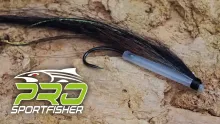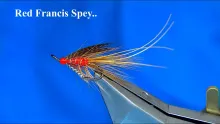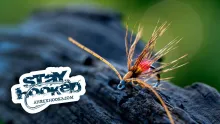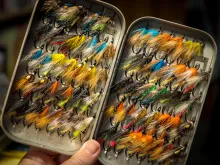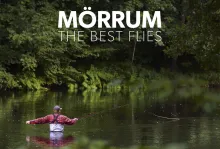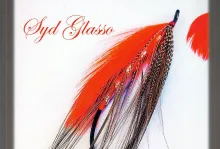In this autumn I had the pleasure of meeting my countryman Poul Jorgensen at two lectures he held here in Jutland, Denmark. One of the flies he tied was his version of Edmund Drury’s famous salmonfly, the General Practitioner. Tied after its original recipe it’s something of a task to make; but Poul has found out a simpler, but just as effective pattern.

In this autumn I had the pleasure of meeting my countryman Poul Jorgensen at two lectures he held here in Jutland, Denmark.
One of the flies he tied was his version of Edmund Drury's famous salmonfly, the General Practitioner. Tied after its original recipe it's something of a task to make; but Poul has found out a simpler, but just as effective pattern.
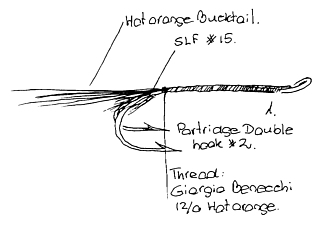
He tied it on a double salmon hook size 2 - the double hook gives it a more stable behaviour in the water and moreover let it sink more readily.
As tying thread he uses the Italian Giorgio Benecchi's 12/0 in the colour Hot Orange. As dubbing he prefers SLF #15 - Hot Orange and for antennae Bucktail in the same colour. For the 'shell' he uses two red breast-feathers from a Golden Pheasant and from the same bird he uses a tippet-feather for eyes!
He starts behind the loop-eye and turns the thread in close turns to the bend. A little down the bend he ties a bunch of SLF dubbing down to form the head. It is fine if these hairs point a little downwards. They must have the same length as the size of the hook-gape. Above it he places a small bunch of Bucktail - protuding the length of the hook to the rear. He doesn't use a stacker as the hairs must be unequal in length.
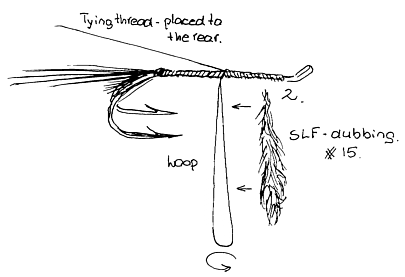
Then he winds the thread to the middle of the hook - forms a big loop, secures it and places the bobbin-holder to the rear of the hook.
From a bunch of SLF he brushes out a sufficient amount of 'wool' and tapers it between his fingers so that it has a point at the end. This end he places nearest to the hook between the two threads of the loop and spins the loop to a firm rope. This he turns backwards over the hook and ties it down in front of the Bucktail - cut surplus and winds the thread as a rib up over the rear-body to the middle of the hook. With a piece of VELCRO glued to the end of his brush he brushes the wool down on both sides to form legs.
On top of the hook he now ties down a red breast-feather from a G.P. First he removes the fluffy fibres at the root and then he adjusts it so that it, when tied down will reach the bend of the hook. But before tying the feather down he squeezes the quill of the feather between the jaws of a pair of flat-nosed pliers. This prevents the feather from turning on the hook and makes it easier to place the feather flat on top of the hook.
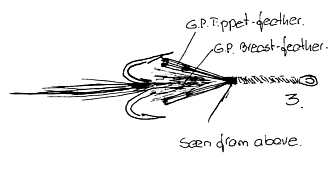
Then he takes a G.P. tippet feather of nearly the same size - removes most of the fibres down to the root and cuts the tip of the feather, so that he only leaves 4-5 fibres of equal length on both sides of the stem. These fibres he glues together with a drop of cement, flattens the quill as described above and ties the feather down on top of the hook. Surplus hackle-stalks are now removed and the thread turned up to the neck of the hook. Here he repeats the procedure: Makes a loop - secures it with a few turns and place the thread to the rear. Places a tapered bunch of SLF between the thread of the loop, twists it tight and turns it to the middle of the hook - just close up to G.P. feathers - winds the thread as a rib and brushes the body on both sides. A red breast-feather is placed on top of the hook, just as before and the fly is finished with nice turns of thread and a whip-finish knot.
When dubbing the final section of the fly Poul aims at letting a little SFL point out over the eye as short tails.
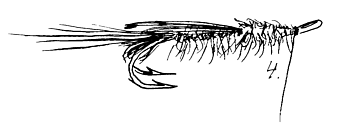

| Hook | Double salmon size 2 |
| Tying thread | Hot orange Bennechi 12/0 |
| 'Tail' | Orange SLF (#15) and hot orange bucktail |
| Body | Hot orange SLF, brushed |
| Eyes | Golden phesant tippet feather |
| Shells | Red golden phesant body feathers |
| Head | Tying thread |
- Log in to post comments

